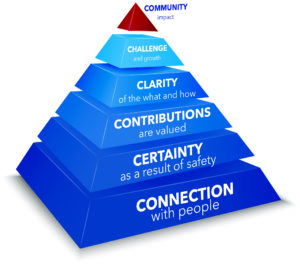I had just finished a conversation with my wife Rachel when I walked upstairs to change my clothes.
I began crying.
Not because of fear. It was the global sadness I felt thinking about how so many peoples’ lives have been impacted. I live in Boulder, Colorado with coaching and leadership training clients in Denver and all across the country. I, like all of us, have seen so many people hurting right now.
During this unprecedented time, we are all scrambling to make sure we stay ahead of the needs of our teams and leaders. We want to emerge from this crisis stronger and more united in our common goals.
To do that, we have to create an environment where people can thrive virtually while keeping in mind that this is a truly human experience.
The challenge is that working virtually lends itself to being disconnected – the exact opposite of our first human workplace need to feel connected. More so, when we distance ourselves from others and retreat from relationships, fear and self-protection increase, along with communication breakdowns and decreased productivity.
To support you and your leaders during this uncertain time, we built a toolkit of strategies to help you lead with a deep level of humanity in a virtual environment.
Here are some tips on how to lead virtual teams with a deep level of humanity. Download our seven-page Leading Virtual Teams with Inspiration Toolkit at the end of the post.
Connection
Connection is our most basic human workplace need. Everyone wants to feel loved and sense that they belong.
Tips:
- Conduct regular 1-1s over video as if you were in the office.
- Schedule daily phone calls with your team members.
- Stand up while on a call or video – your posture influences your voice projection and overall state.
Pitfall to avoid: Letting people feel isolated.
Certainty
People feel certainty when they feel safe. In a traditional office environment that means creating psychological safety. In a work environment like manufacturing, it means both psychological safety and physical safety.
Tips:
- Provide fact-based responses to questions.
- Inform people what new protocols you have in place to maintain their health and safety.
- Create an open environment of communication where people can take risks without fear of punishment or humiliation.
- Be especially intentional with all online communication to avoid misinterpretation.
Pitfall to avoid: Providing feedback or making decisions over email.
Contributions are Valued
At the end of the day, people want to know that they matter, that they’ve been heard and that they are valued.
Tips:
- Conduct virtual recognition rounds via daily calls and reward team members when they model behavior that’s in line with values and business priorities.
- Give team members a voice during virtual meetings.
- Make more time for 1-1s, goal reviews and coaching.
Pitfall to avoid: Failing to demonstrate successes throughout a crisis that could have provided connection between team members.
Clarity on the What and How
People want to know how to succeed, both in terms of business results and what’s expected in the culture.
Tips:
Establish the What (results-oriented expectations):
- Tell people what you know and don’t know.
- Keep people focused on business goals.
- Clarify roles and responsibilities in a virtual environment.
Establish the how (behavioral and values expectations):
- Create new team operating norms based on working in a virtual world.
- Reinforce organization values.
- Measure less obvious impacts like morale, connection and team members’ overall wellbeing.
Pitfall to avoid: Lack of clear and ongoing communication.
Challenge and Growth
There’s an opportunity in any environment, even the virtual world, for people to evolve. Challenge and growth, along with the next human workplace need of community impact, results in true fulfillment at work. When people are growing, they feel fulfilled. When people aren’t learning and growing, they feel like they are losing ground.
Tips:
- Offer stretch assignments or increased responsibilities that current business challenges may naturally create.
- Schedule regular conversations to provide coachable moments.
- Facilitate development opportunities through virtual workshops, online resources, articles, podcasts and more.
Pitfall to avoid: Making goals too aggressive (results in overwhelm) or not making goals aggressive enough (results in boredom).
Community Impact
Our final human workplace need, community impact, is also a need that leads to true fulfillment in the workplace. Use work as your platform to make a bigger difference in this world.
Tips:
- Connect your work to a greater cause.
- Share stories to rally around supporting each other so people can drive to a higher purpose.
- Find ways to collectively support community initiatives.
Pitfall to avoid: Not using your current platform to do what you always dreamed of doing (and it’s probably related to making a contribution).
Get your Leading Virtual Teams with Inspiration Toolkit Here
Download your seven-page Leading Virtual Teams with Inspiration Toolkit here for more strategies on leading virtual teams with a deep level of humanity. Please share it with anyone who may find it helpful.
Together we will persevere.

